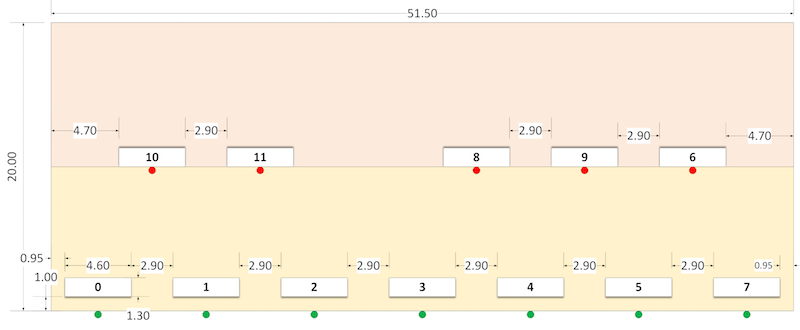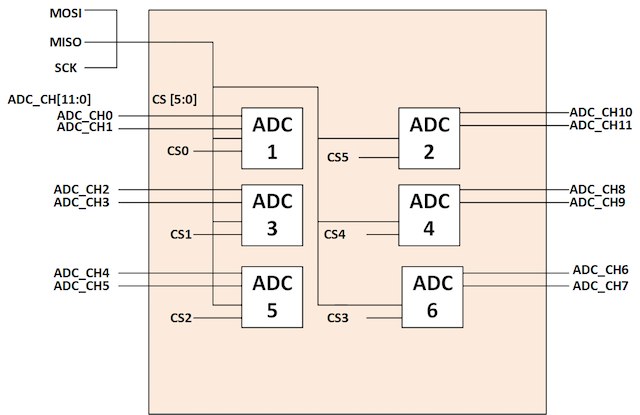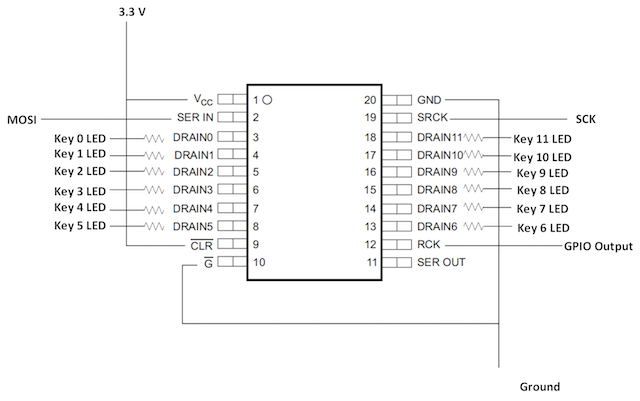Difference between revisions of "F15: Electronic Piano"
Proj user21 (talk | contribs) (→Hardware Design) |
Proj user21 (talk | contribs) (→Hardware Design) |
||
| Line 178: | Line 178: | ||
[[Board Schematic]] | [[Board Schematic]] | ||
[[File:CMPE146 F15 ElectricPiano TopView.png]] | [[File:CMPE146 F15 ElectricPiano TopView.png]] | ||
| + | The board schematic shown displays the precise measurement of the board as well as where the keys are placed on the board. Keys are also assigned 0 to 11. This assignments is referenced by the LED numbering and the ADC_Ch signal. LEDs are placed beneath the keys, with red LEDs associated to the top keys and green LEDs associated to the bottom keys. | ||
[[Power Circuit]] | [[Power Circuit]] | ||
[[SJ-One Board]] | [[SJ-One Board]] | ||
Revision as of 01:23, 17 December 2015
Contents
Grading Criteria
- How well is Software & Hardware Design described?
- How well can this report be used to reproduce this project?
- Code Quality
- Overall Report Quality:
- Software Block Diagrams
- Hardware Block Diagrams
- Schematic Quality
- Quality of technical challenges and solutions adopted.
Project Title
Electronic Piano with Motion Controlled LED Keys
Abstract
The purpose of this project is to design a motion controlled electronic piano powered by an SJ-One Board. The piano will be able to play the notes of a piano using motion sensors as keys. At activation, LEDs will light up the key. The physical size of the piano will cover a single octave; however, the board will provide, the player, control to change the scope of the notes across other octaves.
Objectives & Introduction
Show list of your objectives. This section includes the high level details of your project. You can write about the various sensors or peripherals you used to get your project completed.
Team Members & Responsibilities
- Jason Tran
- Design and write the software
- Design and build the power circuit and ADC circuit
- Arthur Nguyen
- Design and build the wooden frame
- Mount boards and IR keys onto the wooden frame
- Design and build the LED circuit
Schedule
Show a simple table or figures that show your scheduled as planned before you started working on the project. Then in another table column, write down the actual schedule so that readers can see the planned vs. actual goals. The point of the schedule is for readers to assess how to pace themselves if they are doing a similar project.
| Week# | Date | Task | Actual |
|---|---|---|---|
| 1 | 10/30 | Project proposal | Completed. .Went over entire project in theory of both hardware and software design. |
| 2 | 11/6 | Part testing and project outline | Completed testing Sharp IR sensor and MIDI controller interface. |
| 3 | 11/13 | Order parts | Completed order of essential parts including VS1053, short IR sensors,IR jumper wires, and analog to digital converters. Completed software. |
| 4 | 11/20 | Setup all keys with sound. | Completed playing sounds with key activation. |
| 5 | 11/27 | Volume control and power circuit. | Completed. |
| 6 | 12/4 | Combine circuits and start mounting system. | Ordered LEDs and LED driver. Started mounting system onto board. |
| 7 | 12/11 | Build LED circuit and implement software for LEDs. Combine circuits and mount to board. | Completed on 12/16. |
| 8 | 12/17 | Final changes and demo | Completed demo on 12/17. |
Parts List & Cost
Give a simple list of the cost of your project broken down by components. Do not write long stories here.
| Quanitity | Price per part | Part | Detail | Vendor |
|---|---|---|---|---|
| 1 | $80 | SJ-One Board | Microcontroller | SJSU SCE |
| 12 | $13.95 | GP2Y0A41SK0F | Infrared Proximity Sensor Short Range-Sharp | SparkFun |
| 12 | $1.50 | 3-pin JST | Infrared Sensor Jumper Wire | SparkFun |
| 6 | $2.30 | MCP3002 | Analog to Digital Converter | SparkFun |
| 12 | $0.202 | WP59EGW/CA | Red/ Green Diffused Common Anode LED | Mouser |
| 1 | $1.48 | TLC6C5912QPWRQ1 | 12 Channel Shift Register LED Driver | Mouser |
| 1 | $5.42 | LCQT-TSSOP20 | TSSOP to 20DIP Socket Adapter | Mouser |
| 1 | $19.95 | VS1033D | MP3 breakout board/ MIDI decoder | SparkFun |
| 1 | $1.95 | LD1117V33 | 3.3 V voltage regulator | SparkFun |
| 1 | $1.50 | PRT-08032 | 3.5 mm audio jack | SparkFun |
| 2 | $1.25 | PRT-09011 | USB female type A speakers | SparkFun |
| 1 | $13.00 | AL-101 | USB powered speakers | Amazon |
| 24 | $0.04 | MCP3002 | 150 Ohm resistor | Fry's |
Design & Implementation
The design section can go over your hardware and software design. Organize this section using sub-sections that go over your design and implementation.
Hardware Design
Discuss your hardware design here. Show detailed schematics, and the interface here.
Board Schematic
 The board schematic shown displays the precise measurement of the board as well as where the keys are placed on the board. Keys are also assigned 0 to 11. This assignments is referenced by the LED numbering and the ADC_Ch signal. LEDs are placed beneath the keys, with red LEDs associated to the top keys and green LEDs associated to the bottom keys.
The board schematic shown displays the precise measurement of the board as well as where the keys are placed on the board. Keys are also assigned 0 to 11. This assignments is referenced by the LED numbering and the ADC_Ch signal. LEDs are placed beneath the keys, with red LEDs associated to the top keys and green LEDs associated to the bottom keys.
Power Circuit SJ-One Board VS1033 Analog to Digital Converter Circuit
LED Driver
Hardware Interface
SPI was used used to communicate with the ADC devices, the MIDI decoder, and the LED driver. Meanwhile, GPIO was used as control signals, such as chip select and output enable, for the MIDI decoder and the LED driver. In the software, the following SPI and GPIO driver were used to communicate to the IO devices.
SPI driver:
namespace My_spi {
void init_ssp1_spi( void ); // Using SCK1, MISO1, MOSI1 (P0.7, P0.8, P0.9)
void init_cs( uint8_t port, uint8_t pin );
char spi_exchange_byte ( char byte );
void cs_select( uint8_t port, uint8_t pin );
void cs_deselect( uint8_t port, uint8_t pin );
}
For the My_spi driver, the init_ssp1_spi() function initializes LPC1758 SSP controller to function as an SPI controller with the following setting: MSB first, 8-bit data frame, and 500 KHz clock while other settings remained default. The init_cs(port, pin) function initializes a given IO pin to function as a GPIO output used for chip select. cs_select(port, pin) and cs_deselect(port, pin) functions are used to activate and deactivate a given IO pin respectively. Lastly, spi_exchange_byte(byte) function clocks 8-bits to and from a SPI slave device; cs_select(port, pin) and cs_deselect(port, pin) should be called before and after the call of the SPI exchange function(s) to target a specific SPI slave device. Exception: The LED driver is a shift register and does not use chip select. Instead, a GPIO output is used to signal the shift register to update its output (LEDs).
GPIO driver:
namespace My_gpio {
void set_gpio_mode( uint8_t port, uint8_t pin, bool mode );
void digital_write( uint8_t port, uint8_t pin, bool state );
bool digital_read( uint8_t port, uint8_t pin ); // Assuming active high input
}
For the My_gpio driver, the set_gpio_mode(port, pin, mode) function initializes a given IO port to function as a specific GPIO mode (mode can be either input or output). The digital_write(port, pin, state) function sets a given GPIO pin to a given voltage level or state (voltage level can either be high or low). The digital_read(port, pin) function reads the voltage level of a given pin and returns a Boolean value (returns true if high and false if low).
In this section, you can describe how your hardware communicates, such as which BUSes used. You can discuss your driver implementation here, such that the Software Design section is isolated to talk about high level workings rather than inner working of your project.
Software Design
Show your software design. For example, if you are designing an MP3 Player, show the tasks that you are using, and what they are doing at a high level. Do not show the details of the code. For example, do not show exact code, but you may show psuedocode and fragments of code. Keep in mind that you are showing DESIGN of your software, not the inner workings of it.
Implementation
This section includes implementation, but again, not the details, just the high level. For example, you can list the steps it takes to communicate over a sensor, or the steps needed to write a page of memory onto SPI Flash. You can include sub-sections for each of your component implementation.
Testing & Technical Challenges
Describe the challenges of your project. What advise would you give yourself or someone else if your project can be started from scratch again? Make a smooth transition to testing section and described what it took to test your project.
Include sub-sections that list out a problem and solution, such as:
LED driver soldering
At first, the LED driver had difficulty implementing. The problem that occurred was that the soldering of the LED driver to the TSSOP to DIP20 adapter may have created a short along the way. After fixing the soldering, the data was able to be sent to the LED driver as expected.
ADC chip select
Conclusion
Conclude your project here. You can recap your testing and problems. You should address the "so what" part here to indicate what you ultimately learnt from this project. How has this project increased your knowledge?
Project Video
Project Source Code
References
Acknowledgement
Any acknowledgement that you may wish to provide can be included here.
References Used
Short IR data sheet Media: CMPE146_F15_ElectricPiano_shortIR.pdf
Analog to digital converter datasheet Media: CMPE146_F15_ElectricPiano_ADC.pdf
LED driver data sheet Media:CMPE146_F15_ElectricPiano_LEDdriver.pdf
Appendix
You can list the references you used.

